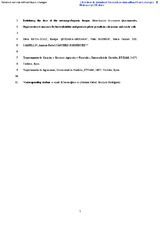Mostrar el registro sencillo del ítem
Redefining the dose of the entomopathogenic fungus Metarhizium brunneum (Ascomycota, Hypocreales) to increase Fe bioavailability and promote plant growth in calcareous and sandy soils
| dc.contributor.author | Raya Díaz, Silvia | |
| dc.contributor.author | Quesada-Moraga, Enrique | |
| dc.contributor.author | Barrón, Vidal | |
| dc.contributor.author | Campillo, María del Carmen del | |
| dc.contributor.author | Sánchez-Rodríguez, Antonio Rafael | |
| dc.date.accessioned | 2024-02-01T07:44:43Z | |
| dc.date.available | 2024-02-01T07:44:43Z | |
| dc.date.issued | 2017 | |
| dc.identifier.issn | 0032-079X | |
| dc.identifier.uri | http://hdl.handle.net/10396/26920 | |
| dc.description.abstract | Background and aims: Entomopathogenic mitosporic ascomycetes Beauveria, Metarhizium and Isaria sp. are commonly used for pest control but can also serve other, lesser known functions such as increasing nutrient bioavailability or promote plant growth. The objective of this work was to identify the doses of entomopathogenic fungi (EF) to be applied to soil in order to modify iron (Fe) uptake by plants and promote their growth. Methods: We used an in vitro assay to assess the ability of Beauveria bassiana, Metarhizium brunneum and Isaria farinosa to mobilize Fe from nine Fe oxides differing in composition, particle size and crystallinity, including ferrihydrite, hematite, goethite and magnetite. We also conducted an in vivo assay by applying five different doses (viz., 0, 5 × 102, 5 × 104, 5 × 106 and 5 × 108 conidia ml−1) of a conidial suspension of M. brunneum to the surface of a calcareous soil, which induced Fe chlorosis and a non–calcareous soil which did not induce chlorosis to explore the ability of the fungus on improving Fe nutrition and plant growth of sorghum and sunflower plants. Results: In the in vitro assay, all three EF increased Fe availability differently depending on particle size and crystallinity, and I. farinosa and B. bassiana increased the pH of the culture medium, whereas M. brunneum did not produce a great effect. In the in vivo assay, the highest dose (5 × 108 conidia ml−1) of M. brunneum alleviated Fe chlorosis symptoms of sorghum plants grown in the calcareous soil, and the two highest doses (5 × 106 and 5 × 108 conidia ml−1) increased plant height and inflorescence production of sunflower grown in both soils. Conclusions: The observed benefits of EF on plant growth and nutrition provide support for more sustainable and cost–effective use of these biocontrol agents. | es_ES |
| dc.format.mimetype | application/pdf | es_ES |
| dc.language.iso | eng | es_ES |
| dc.publisher | Springer | es_ES |
| dc.rights | https://creativecommons.org/licenses/by-nc-nd/4.0/ | es_ES |
| dc.source | Raya–Díaz, S., Quesada‐Moraga, E., Barrón, V., Del Campillo, M. C., & Sánchez–Rodríguez, A. R. (2017). Redefining the dose of the entomopathogenic fungus metarhizium brunneum (Ascomycota, hypocreales) to increase FE bioavailability and promote plant growth in calcareous and sandy soils. Plant and Soil, 418(1-2), 387-404. https://doi.org/10.1007/s11104-017-3303-0 | es_ES |
| dc.subject | Isaria farinosa | es_ES |
| dc.subject | Beauveria bassiana | es_ES |
| dc.subject | Plant growth promoter | es_ES |
| dc.subject | Calcareous soil | es_ES |
| dc.subject | Non–calcareous soil | es_ES |
| dc.subject | Sandy soil | es_ES |
| dc.subject | Iron nutrition | es_ES |
| dc.subject | Iron chlorosis | es_ES |
| dc.title | Redefining the dose of the entomopathogenic fungus Metarhizium brunneum (Ascomycota, Hypocreales) to increase Fe bioavailability and promote plant growth in calcareous and sandy soils | es_ES |
| dc.type | info:eu-repo/semantics/article | es_ES |
| dc.relation.publisherversion | https://doi.org/10.1007/s11104-017-3303-0 | es_ES |
| dc.relation.projectID | Junta de Andalucía. AGR-7681 | es_ES |
| dc.rights.accessRights | info:eu-repo/semantics/openAccess | es_ES |

